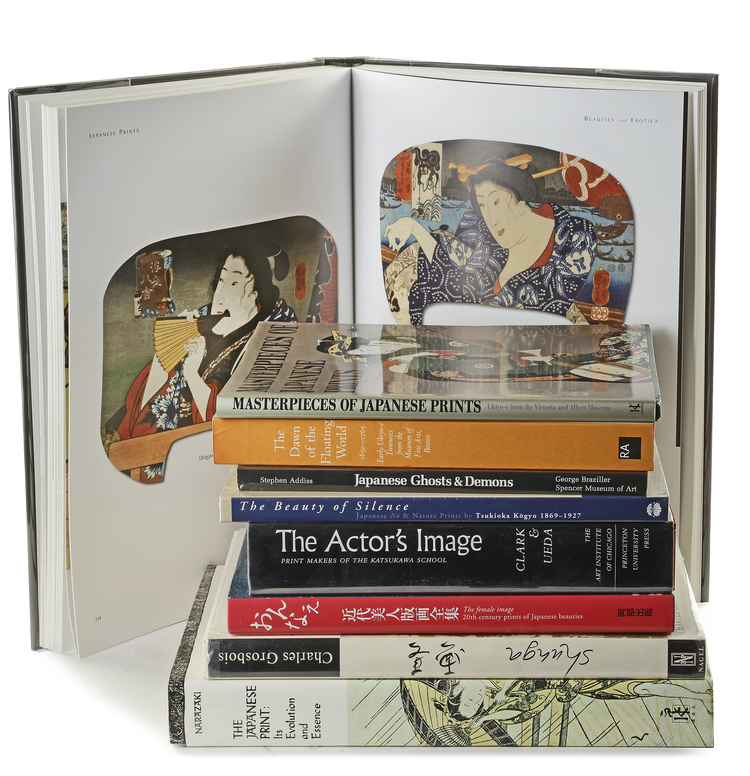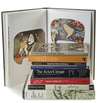BOOKS ON JAPANESE PRINTS
"Narazaki, Muneshige. The Japanese Print: Its Evolution and Essence. Tokyo: Kodansha, 1966. First Edition. 274 Pages, 107 tipped-in colour plates, bibliography, glossary, index. Original slipcase. This book introduces the reader to the aesthetics and techniques of Japanese prints, including a chapter on collecting prints. All plates in colour with full descriptions and a note on the artist. English adaptation by C. H. Mitchell. A masterpiece! Robert Schaap & J. Thomas Rimer. The Beauty of Silence - Japanese No & Nature Prints by Tsukioka Kogyo - 1869 – 1927. Leiden: Hotei, 2010. First Edition. 192 pages, text in English, full colour images throughout. The Beauty of Silence. Japanese No and Nature Prints by Tsukioka Kogyo (1867-1927) is the first monograph in English on Tsukioka Kogyo, one of the lesser-known exponents of Japanese woodblock prints of the Meiji period (1868-1912). This publication exposes Kogyo´s life and work, presenting a detailed and abundantly-illustrated overview of his rich oeuvre of prints and paintings, and places them in the context of his times. For the first time, Kogyo´s life and work are accessible to readers throughout the world. Clark, Timothy & others. The Actor's Image: Print Makers of the Katsukawa School. Chicago: Princeton University Press, 1994. First edition. 503 Pages, illustrated in colour and black and white. The ""floating world""--the closely related pleasure and entertainment districts of Tokyo in the eighteenth and nineteenth centuries--embodied and idealized fashion, chic, and urbanity for its habitudes, and inspired a profusion of woodblock prints depicting renowned courtesans and adored matinee idols. Considered ephemera in their time, these prints are treasured works of art today. In this volume of ""floating world prints"" (ukiyo-e), the authors present a selection of Kabuki actor portraits and theatre scenes from The Art Institute of Chicago's world-renowned Buckingham Collection of Japanese Prints. Together with interpretive essays that place the prints in their historical and cultural context, the authors offer a catalogue of 880 prints, 136 of them in colour, containing the most complete and up-to-date information available about each print. Donald Jenkins's essay explains printmaking and explores the lives and milieu of the Katsukawa school print makers. Timothy Clark, in his essay, vividly depicts the world of Kabuki theater and describes a particular production of a popular play, from the vantage points of various participants. Osamu Ueda has provided dates and identification for the subjects of many of the prints in the collection, as well as biographies of the leading Kabuki actors and brief lives of the printmakers of the Katsukawa school Addiss, Stephen. Japanese Ghosts and Demons - Art of the Supernatural. New York: George Braziller, 1985. First edition. 192 Pages, 49 colour and 75 black-and-white illustrations. A fine work on Japanese prints in which ghosts and demons are the main subject. Clark, Timothy & others. The Dawn of the Floating World - 1650-1765: Early Ukiyo-E. Treasures From the Museum of Fine Arts, Boston London: Royal Academy of Arts, 2002. First Edition. 335 pages, text in English. Full colour images as well as black & white. Catalogue to accompany the exhibition. It contained many exquisite pieces from the Museum of Fine Arts in Boston, many of which have never been seen outside the museum. Essays by authorities on the subject attributed to this publication. The floating world is an era in the Japanese wood block prints (1650-1765) that is most known outside of Japan. This exhibition is a perfect overview of the styles, subjects and themes. The essays give laymen and scholar a thorough insight into the development of this art form. Grosbois, Charles. Shunga - Images of Spring. Essay on Erotic Elements in Japanese Art. Geneva: Nagel Publishers, 1964. First edition. 157 Pages, tipped-in colour plates. An excellent book on the subject of erotism in Japanese art. Shinji Hamanaka & Amy Reigle Newland. The Female Image - 20th century prints of Japanese Beauties. Leiden: Hotei Publishing, 2000. First Edition. 215 Pages, many full colour images. Text in English and Japanese. The female image is a comprehensive survey of the genre of bijinga ('prints of beautiful women') produced in the Shin hanga tradition that evolved in the early 20th century. This bilingual (Japanese/English) publication is lavishly illustrated with works from Japanese, European and American public and private collections. Prints by major artists such as Hashiguchi Goyo (1880-1921), Torii Kotondo (1900-76) and Ito Shinsui (1898-1972) are included, as are examples from more obscure print designers which have rarely been reproduced. And 2 other books."


